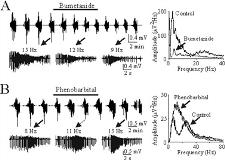DRUG RESISTANCE, p53 AND ELECTRICAL STIMULATION OF EPILEPTIC AND TUMOR CELLS
Abstract number :
3.166
Submission category :
Year :
2005
Submission ID :
5972
Source :
www.aesnet.org
Presentation date :
12/3/2005 12:00:00 AM
Published date :
Dec 2, 2005, 06:00 AM
Authors :
Catalin Perju, Luca Cucullo, Kerri Hallene, Vince Fazio, Mukesh Agarwal, and Damir Janigro
The drug resistance mechanism (P-gp or MDR1) is thought to play a major role in AED drug extrusion and in the intrinsic drug resistance of malignant tumors. Human epileptic astrocytes and certain malignant tumors share in common lack of functional p53, and both respond to electrical stimulation (ES) with reduced cell cycle. We tested the hypothesis that p53 expression and ES both influence expression of multiple drug resistance pumps in epileptic and tumor tissues. p53 and MDR1 expression was quantified by Western blotting. Primary glial cultures obtained from human epileptic subjects and drug resistant tumor cell lines were exposed to AC stimulation. Western blot analysis and immunohistochemical assays was used to a) measure expression levels of MDR1, b) compare the expression and cellular distribution of this transporter between the stimulated and the control groups; c) measure drug uptake in stimulated and control groups. p53 expression correlated inversely with expression of MDR1. Cells lacking functional p53 had elevated MDR1 levels while stable transfection of p53 negative human glia with p53 resulted in decreased MDR1 levels. 50 Hz low intensity (7.5 mA) AC stimulation enhanced permeability of tumor cell lines and epileptic astrocytes to the MDR1 substrate doxorubicin. The effect was comparable to the one observed by exposing non-stimulated cultures to the MDR1 inhibitor XR 9576. Immunohistochemical and Western blot analysis have also revealed that electrical stimulation not only significantly decreased the expression of the ABC transporter MDR1 but change the cellular topography of MDR1 expression. ES promoted translocation of MDR1 from the cellular membrane into the cytosol, resulting in loss of drug extrusion potency. 1) The cell cycle-apoptosis protein p53 controls MDR1 expression in human epileptic brain and tumor cells; 2) Deep Brain Stimulation-like electrical stimulation reduces MDR1 activity, thus facilitating the passage of AEDs and chemotherapic agents across cellular membranes.[figure1] (Supported by NIH-2RO1 HL51614, NIH-RO1 NS 43284, NIH-RO1 NS38195 to Damir Janigro and by The Alternatives Research [amp] Development Foundation grant award to Luca Cucullo.)
